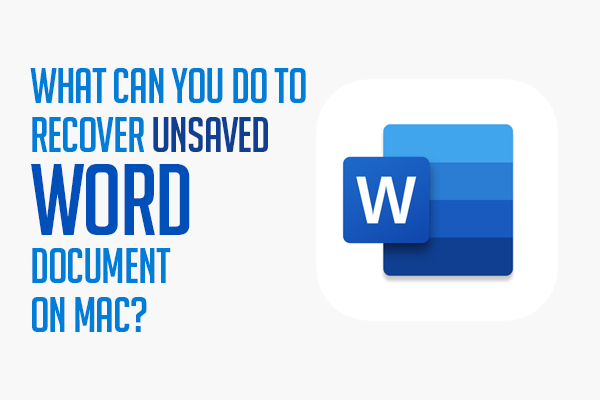One of the nightmares for Mac users is that the Mac suddenly shuts down before saving the files you are working on. Imagine you’ve already written hundreds of words in Microsoft Word but a simple power outage can place your efforts in vain. Miserable experience indeed.
The priority now comes to how to recover unsaved Word document on Mac before it’s gone for good. This post lists some commonly-seen missing Word document situations and sheds a light on what can you do to recover deleted and lost Word files on Mac with a detailed step-by-step guide. Read on if you encounter the same trouble.
Word document data loss scenarios and fixes
Besides the unsaved Word file, there are other Word loss situations reported by Mac users. You may go for the one you’re in and follow the methods.
You forget to save the document before leaving Word.
Possibly, the Mac is running out of battery and the computer turns off before you can do anything about the document. Or some programs result in Mac crashing or getting frozen and the whole system shuts down. Normally when you restart the Mac and open the Word page where it’s left, a pop-up window will ask you to restore the page, at least a recent version of the file. So, there’s a chance you can get back to where the text ends and continue to work on it.
The reason lies in the AutoSave function included in Microsoft Word. This feature will save your file automatically if enabled beforehand. You can check it at the top of the menu bar. In case the document doesn’t load up as expected, you can find the previous version below.
Finder > Go in the menu bar > Go to folder… > Paste the following path.
/Library/Containers/com.microsoft.Word/Data/Library/
Preferences/AutoRecovery
You’ll be led to the folder that contains unsaved Word docs. See if you can find the desired one.
You wish to downgrade the document and have an earlier version of it.
In some cases, Mac users prefer an older version of the file. Luckily, Microsoft Word can meet your demands if you have the first version saved. Then you can freely browse the version history to find the one you prefer. Here’s how to fulfill that.
Step 1. Launch Microsoft Word. With the page open, click on File from the top menu bar.
Step 2. Find Browse Version History from the drop-down list.
Step 3. A Version History column should appear at the right section of the Word interface with all saved versions. Go for the correct version you want.
Step 4. Click on Open Version under the document. You’ll be led to the second copy of the file.
Step 5. Two options are offered now. One is to Restore and the other is to Compare. The first option is to go back to the appointed version and the latter one allows you to compare the differences between the two versions.
You delete the Word document but regret doing so.
This happens when users remove unnecessary files to make room for the Mac but later realize something important gets involved as well. Fortunately for all, Word documents under this circumstance can be easily retrieved from Trash.
Step 1. Click on the trash bin icon at the right in the Dock.
Step 2. Enter the trash folder and you should see all deleted files with a timeline. Locate the document by time. Click on an item and press the Space bar so you can preview the file. In case you can’t find it, dig into a folder named Recovered items. It’s possible your files are hidden there.
Step 3. Select the item you want to recover and right-click on it. Choose Put Back from the menu list. The Word document will be restored to its original location so you can easily find it.
The document is missing and all the above methods aren’t helpful.
Perhaps it’s really not your day and the methods mentioned above are doing no good, there’s one thing you can try that is to use professional data recovery software to recover unsaved or missing Word files. Here we take iBoysoft Mac Data Recovery for example. This data recovery software is easy to use with a few clicks in the clear-designed graphical interface. See how iBoysoft Data Recovery for Mac works the magic.
Step 1. Free download iBoysoft data recovery software from the official site and install it on your macOS. Place the software in a different location from where the document is stored. Enable the system extension if you’re asked to.
Step 2. Run the program once it’s well installed. Select the folder that stores the previously deleted or missing files, say, the Mac hard drive.
Step 3. Find the blue Scan button in the right corner and click it for scanning.
Step 4. Among all scanned results, type in the file name in the search bar located at the upper right of the window. Alternatively, you can filter the results to find desired documents. Preview the files by pressing the Space bar if you find it necessary.
Step 5. Click on Recover to restore your docs and assign a new location for the recovered items.














